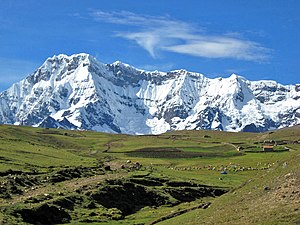Ausangate
| Ausangate | ||
|---|---|---|
|
Summit of Ausangate |
||
| height | 6384 m | |
| location |
Cusco Region ( Peru )
|
|
| Mountains | Cordillera Vilcanota ( Andes ) | |
| Coordinates | 13 ° 47 '19 " S , 71 ° 13' 52" W | |
|
|
||
| First ascent | 1953 by Heinrich Harrer , Jürgen Wellenkamp, Fritz März, Heinz Steinmetz | |
The Ausangate (also Auzangate , Quechua : Awsanqati ) is the fifth highest mountain in Peru with a height of 6384 m . It is located southeast of Cusco on the western edge of the Cordillera Vilcanota . Its first ascent took place in 1953 by Jürgen Wellenkamp, Fritz März, Heinz Steinmetz and Heinrich Harrer over the West Ridge, after Mathias Rebitsch had failed a year earlier.
In addition to climbing the mountain, there is also the possibility of a (around five-day) circumnavigation. This leads over four passes (about 5000 m ) and offers a beautiful view of glaciers and mountain lakes.
Religious meaning
Every year, on the north side of Ausangate, shortly before the Corpus Christi festival, the Quyllur Rit'i (“Snow Star Festival ”) is celebrated over several days . Thousands of people, the majority of them indigenous people , make a pilgrimage with their families to the snow-covered heights to the church of Sinakara and offer sacrifices to the image of the "Lord of Quyllur Rit'i", a crucifix famous for its miraculous activity, as well as to Apu Ausangate and other mountain deities, to secure the potato harvest and rich livestock yield for the coming year. The pilgrims celebrate fairs , sacrifice candles, pray and leave their wishes in a kind of game symbolically already a reality by building, for example, miniature houses, purchase a counterfeit degree or large sums of play money can give and about toy cars for sale, doll furniture or similar items or pay back their bank debts. In addition, various groups of costumed dancers organize traditional parades and ceremonies.
The ukukus , called "bears" ( Cusco-Quechua : ukuku ) or "guardians", are traditionally the sons of a bear and a human woman . They wear wool masks called "Waq'ollo" and torn clothes, keep the camp in order and, on the penultimate day, go on a dangerous walk to the sanctuary on the glacier, where they spend the night. The return of Ukukus the pilgrim camp on the last day at sunrise represents the culmination of the festival represents. Traditionally, the guards bring pieces of ice with which they have cut off from the glacier, and distribute them among the faithful (which however has been banned in recent years by the Church , supposedly because the glacier is melting as a result of climate change ). The ice is used as healing water against diseases. The procession, during which ukukus are regularly killed (which is interpreted by many as a manifestation of the mountain god and a good omen), is considered to be the renewal of the covenant with the mountain god. Traditional and Christian customs are mixed up.
literature
- Karl Gratzl: The Mountain Myth. Lexicon of the important mountains from mythology, cultural history and religion . Hollinek, Purkersdorf 2000, ISBN 3-85119-280-X , p. 42 .
- Fritz March: A tightrope walk. Notes about mountaineering and the Alpine Club . Rosenheimer, Rosenheim 1992, p. 42 .

